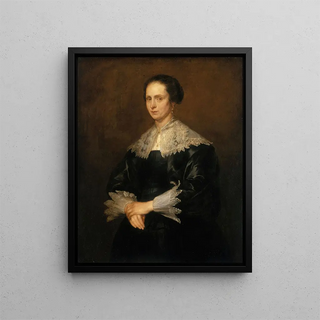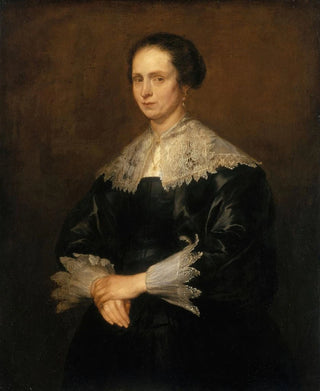Art print | Helena Tromper Du Bois - Antoine van Dyck


View from behind

Frame (optional)
In the world of Baroque painting, few artists have captured with such finesse the complexity of human emotions as the Flemish master Antoine van Dyck. His artwork "Helena Tromper Du Bois" stands out for its psychological depth and formal elegance that transcend time. This depiction of a woman with an penetrating gaze and graceful posture invites the viewer to explore the subtleties of her soul. The light and shadow in this composition, as well as the meticulous details of the costume, testify to an exceptional craftsmanship, making this piece a true masterpiece of 17th-century painting.
Style and uniqueness of the work
The uniqueness of "Helena Tromper Du Bois" lies in how van Dyck manages to combine realism with a certain idealization. Every brushstroke seems imbued with a profound intention, where the texture of fabrics and the delicacy of features intertwine to create a striking visual harmony. The color palette chosen by the artist, oscillating between warm tones and darker shades, enhances the introspective nature of the scene. The background, often blurred, highlights the main subject, creating a contrast that inevitably draws the eye. Helena's posture, both confident and reflective, evokes a mystery that invites contemplation. This work is not just a simple representation; it tells a story, that of a woman whose beauty and depth of soul are eternal.
The artist and his influence
Antoine van Dyck, a pupil of Rubens, established himself as one of the most influential portraitists of his time. His style, characterized by a dynamic approach to portraiture, marked a turning point in 17th-century art. Van Dyck was able to translate the nobility and dignity of his subjects with a sensitivity unique to him, influencing many artists across the ages. His works, such as "Helena Tromper Du Bois," reflect an era when portraiture became a means of personal and social expression. The artist not only left a pictorial legacy but also contributed to red

Matte finish

View from behind

Frame (optional)
In the world of Baroque painting, few artists have captured with such finesse the complexity of human emotions as the Flemish master Antoine van Dyck. His artwork "Helena Tromper Du Bois" stands out for its psychological depth and formal elegance that transcend time. This depiction of a woman with an penetrating gaze and graceful posture invites the viewer to explore the subtleties of her soul. The light and shadow in this composition, as well as the meticulous details of the costume, testify to an exceptional craftsmanship, making this piece a true masterpiece of 17th-century painting.
Style and uniqueness of the work
The uniqueness of "Helena Tromper Du Bois" lies in how van Dyck manages to combine realism with a certain idealization. Every brushstroke seems imbued with a profound intention, where the texture of fabrics and the delicacy of features intertwine to create a striking visual harmony. The color palette chosen by the artist, oscillating between warm tones and darker shades, enhances the introspective nature of the scene. The background, often blurred, highlights the main subject, creating a contrast that inevitably draws the eye. Helena's posture, both confident and reflective, evokes a mystery that invites contemplation. This work is not just a simple representation; it tells a story, that of a woman whose beauty and depth of soul are eternal.
The artist and his influence
Antoine van Dyck, a pupil of Rubens, established himself as one of the most influential portraitists of his time. His style, characterized by a dynamic approach to portraiture, marked a turning point in 17th-century art. Van Dyck was able to translate the nobility and dignity of his subjects with a sensitivity unique to him, influencing many artists across the ages. His works, such as "Helena Tromper Du Bois," reflect an era when portraiture became a means of personal and social expression. The artist not only left a pictorial legacy but also contributed to red






